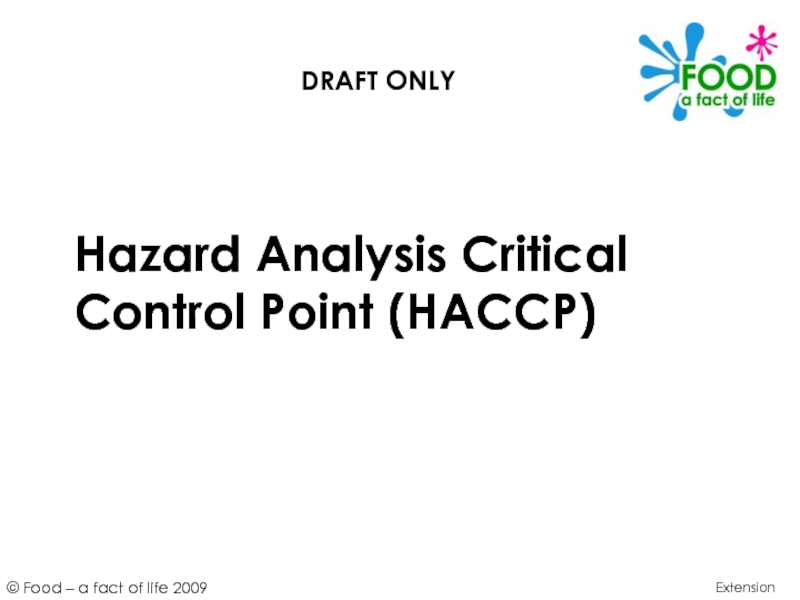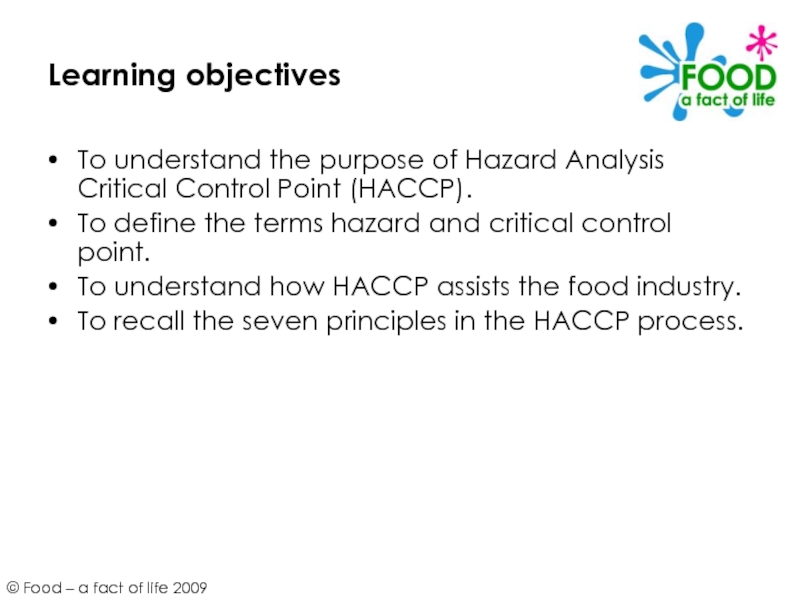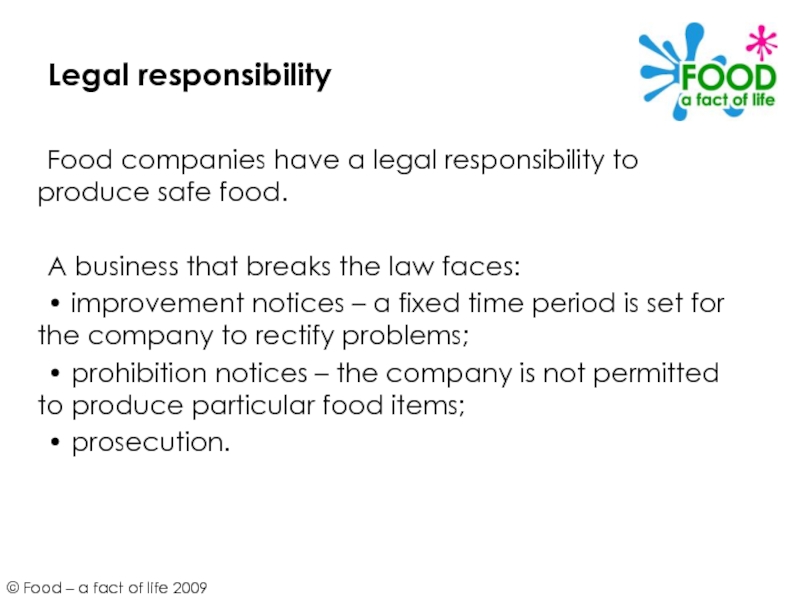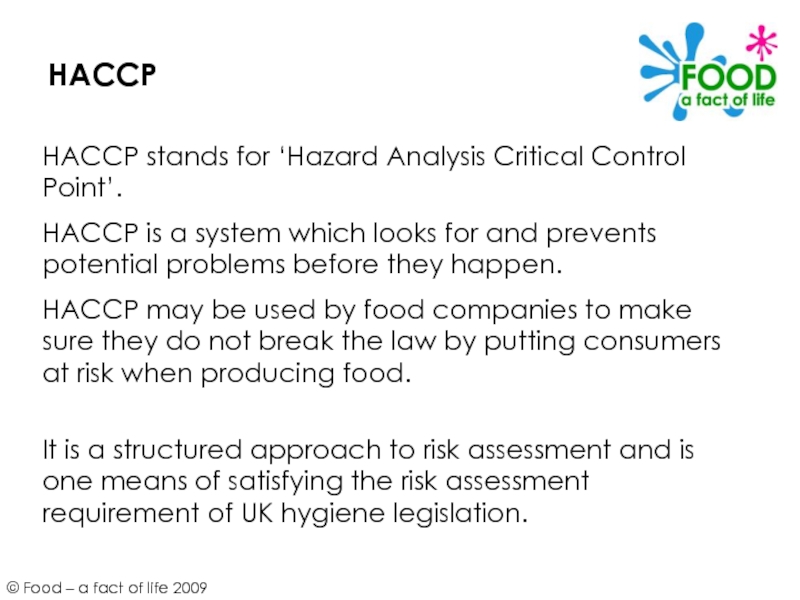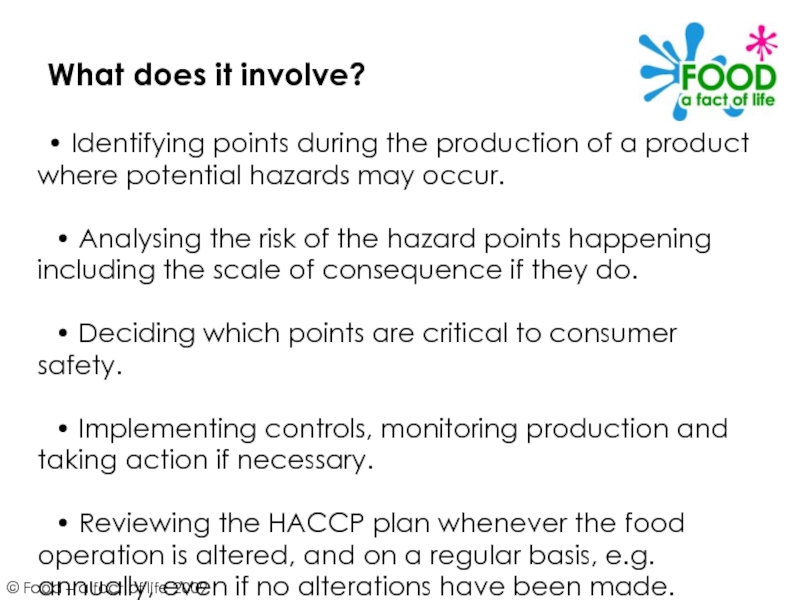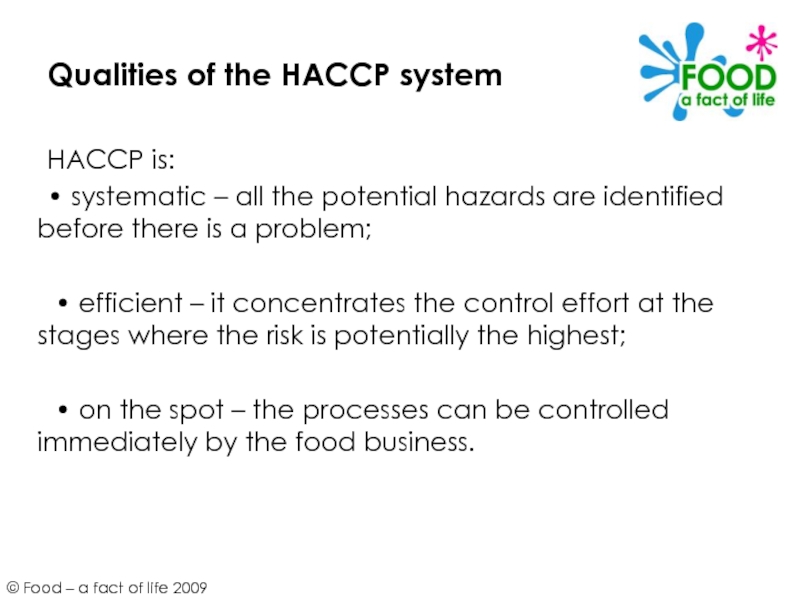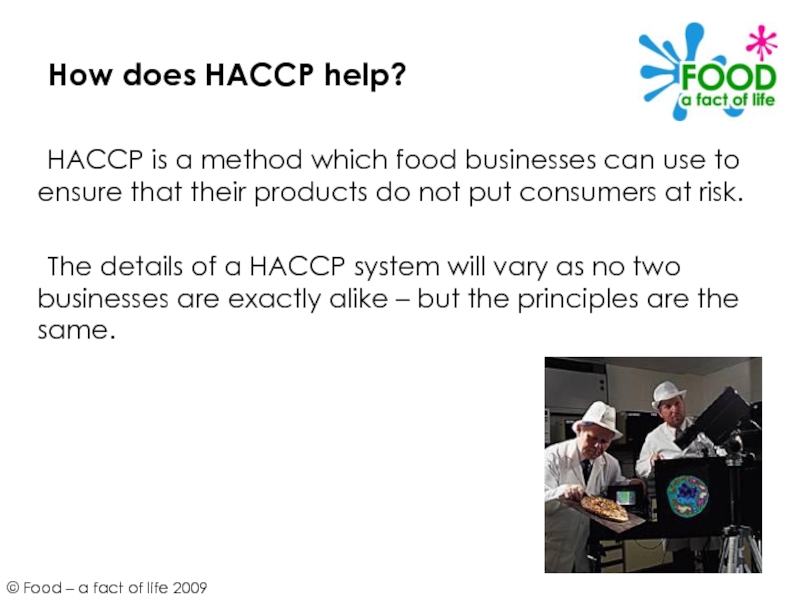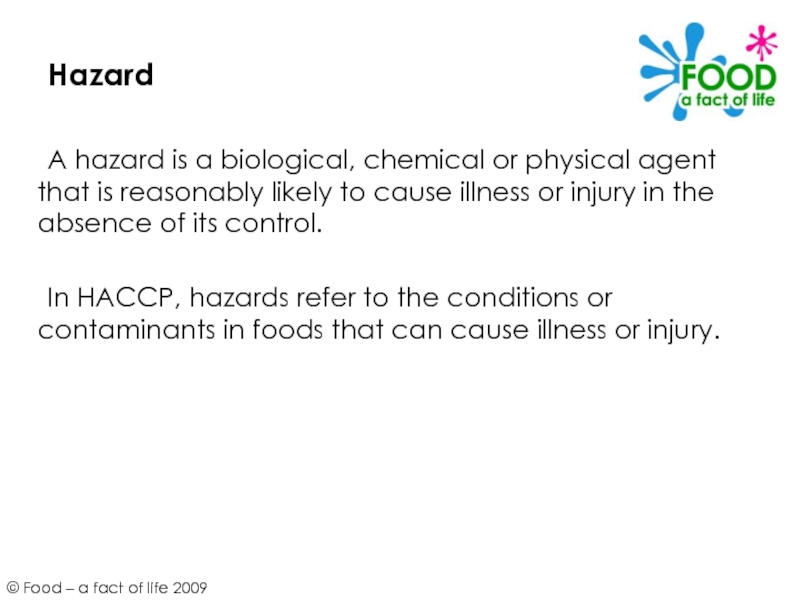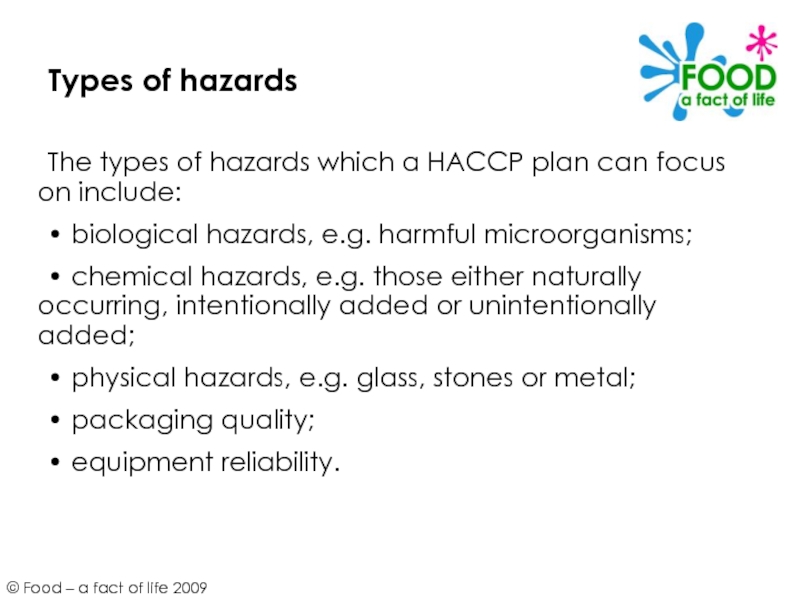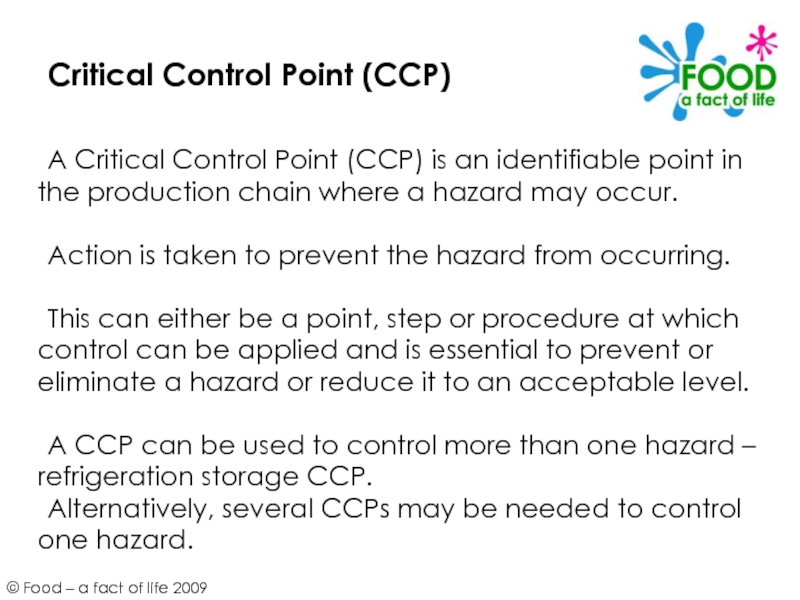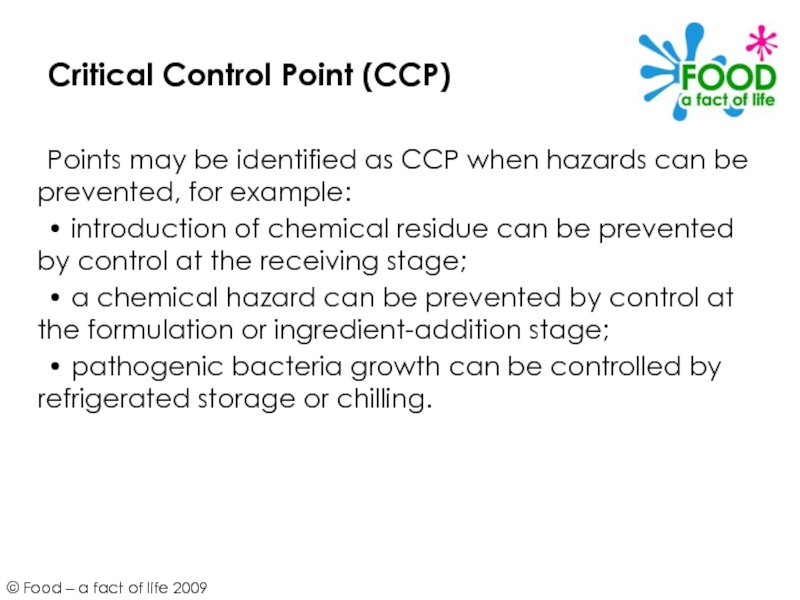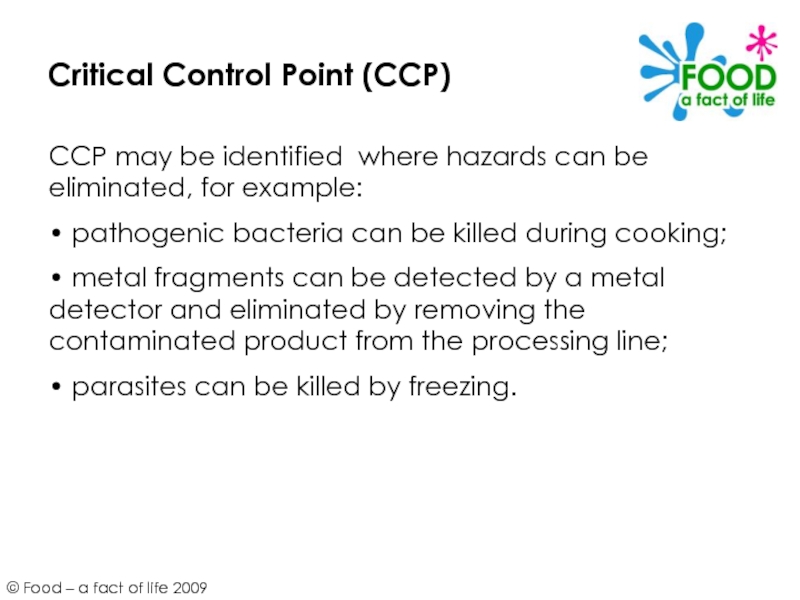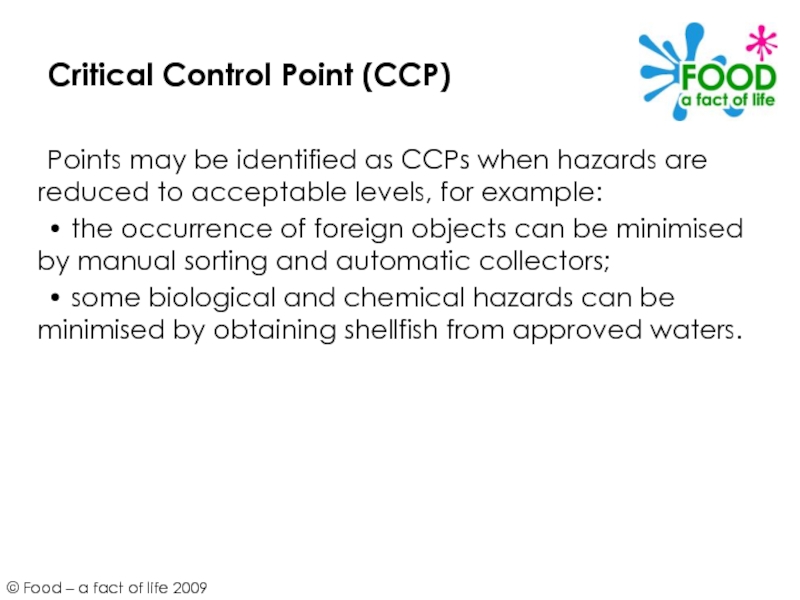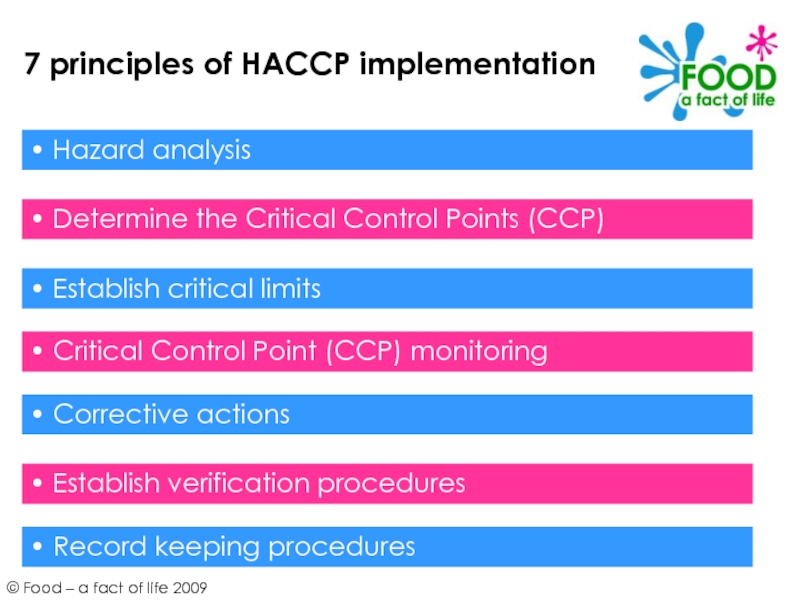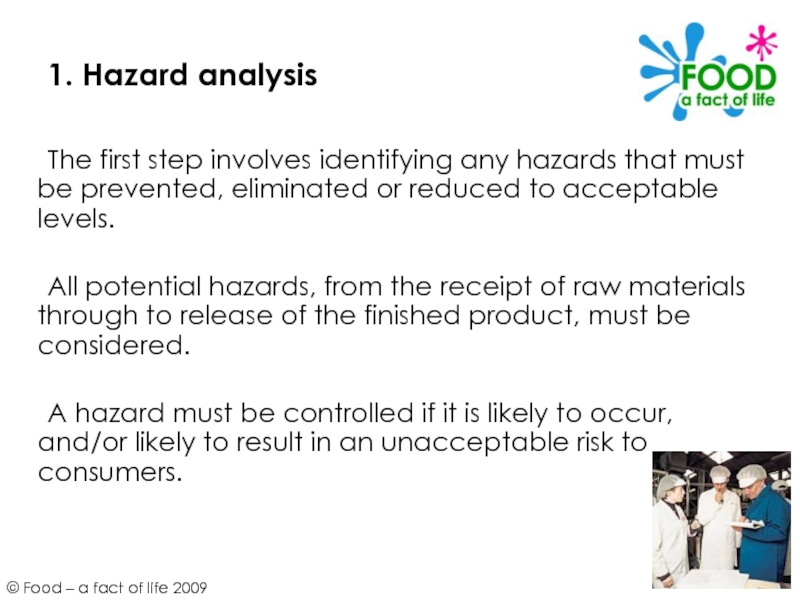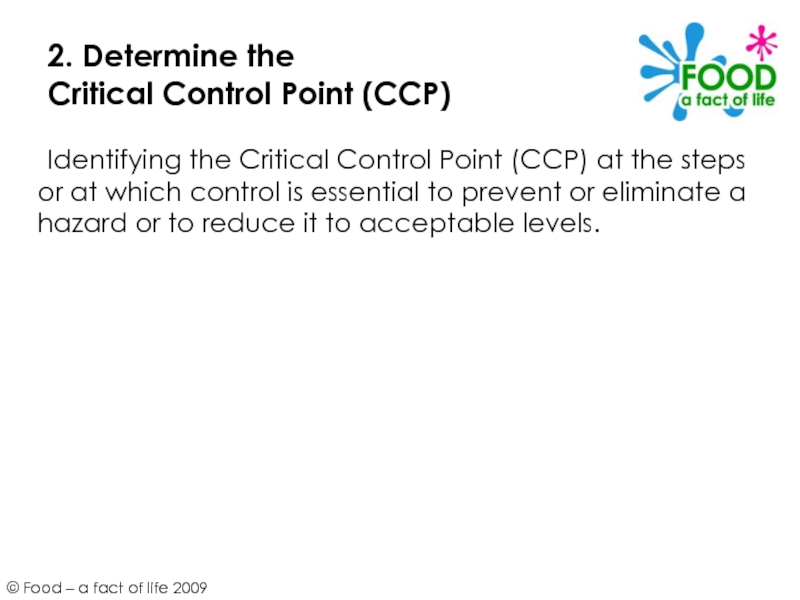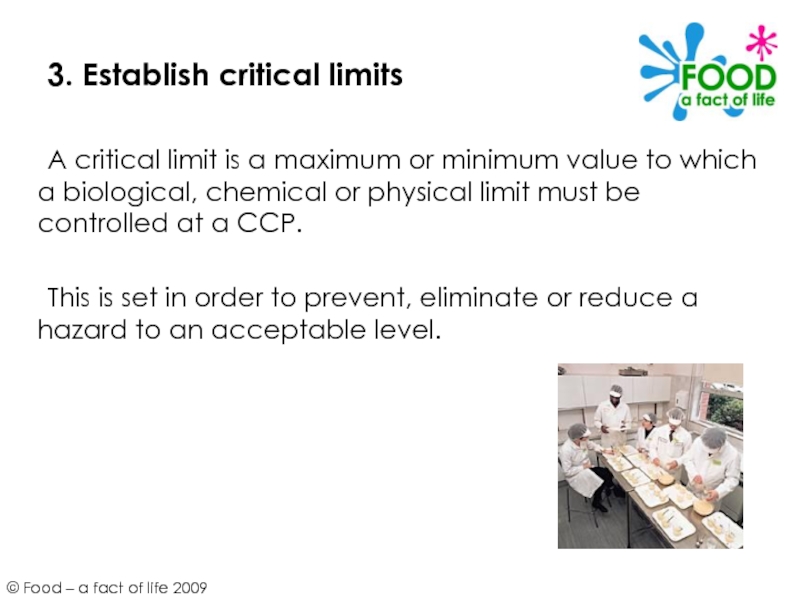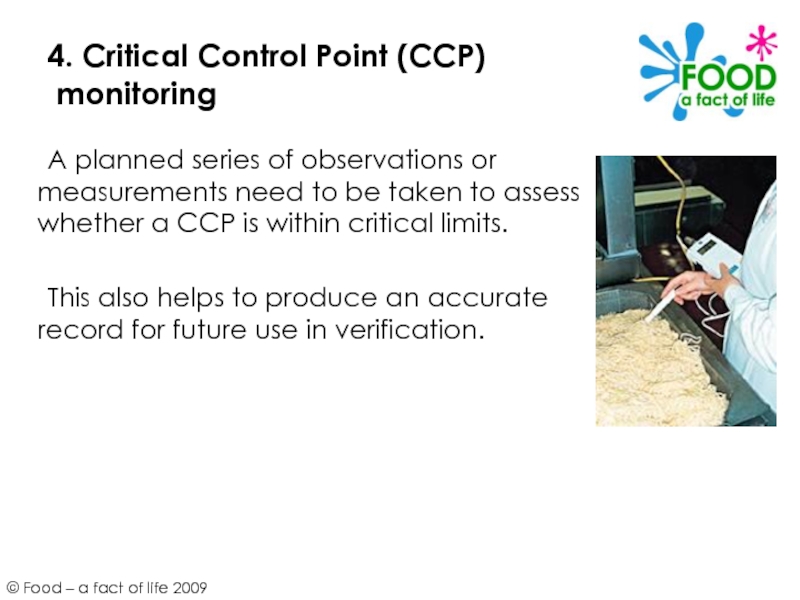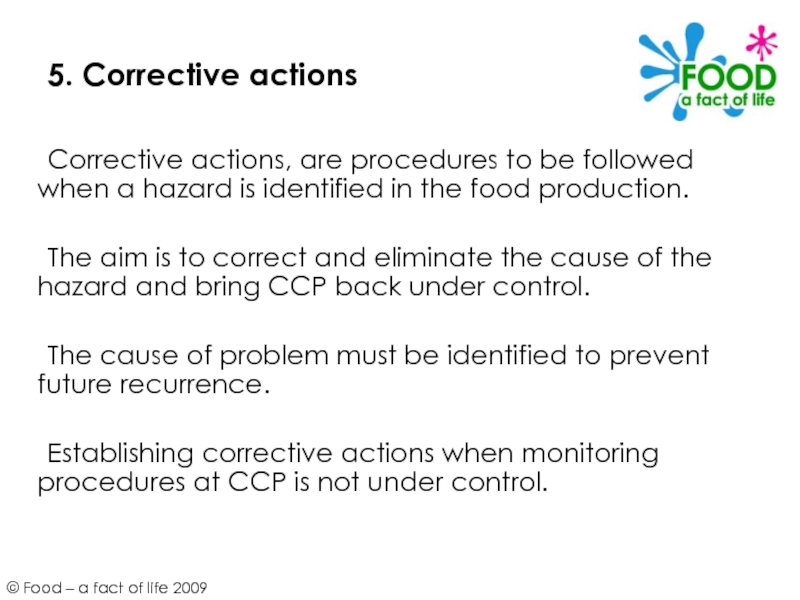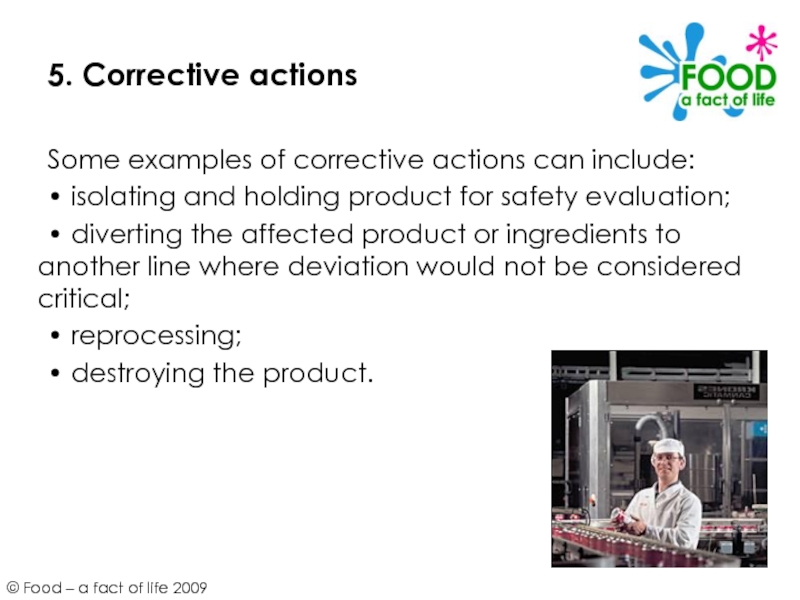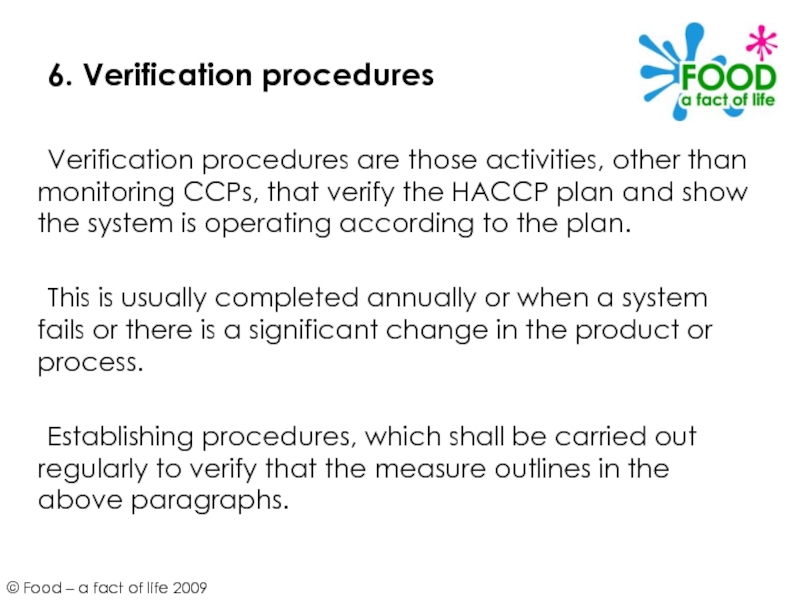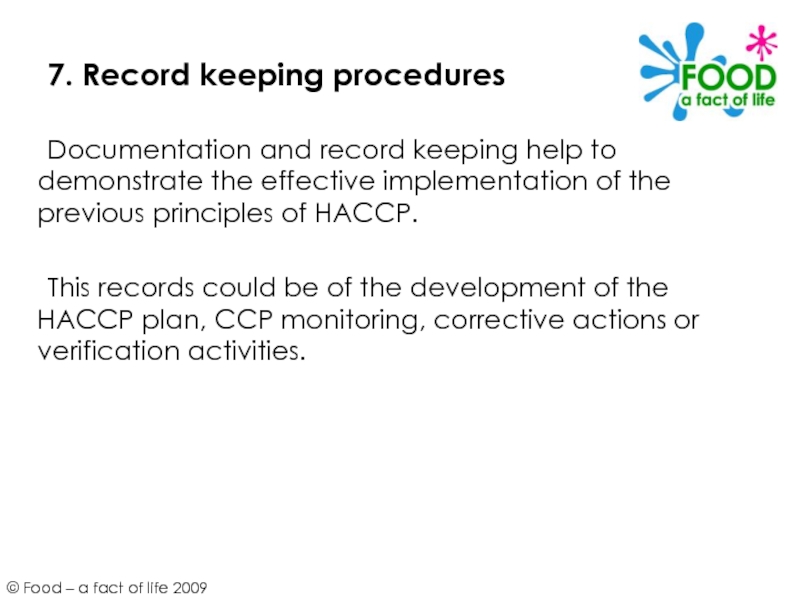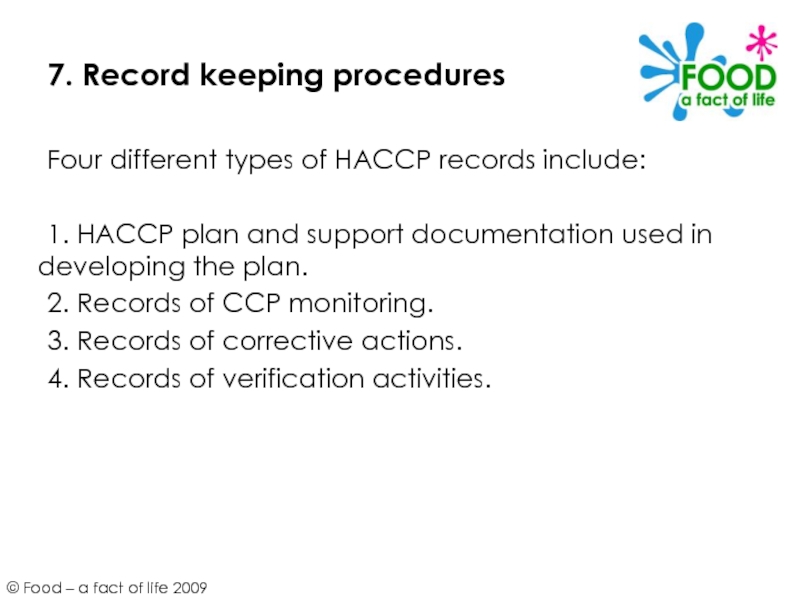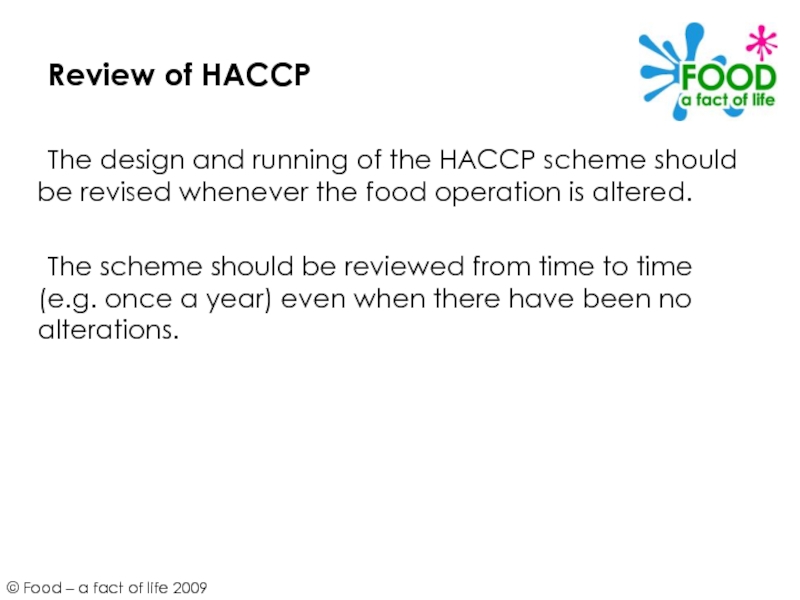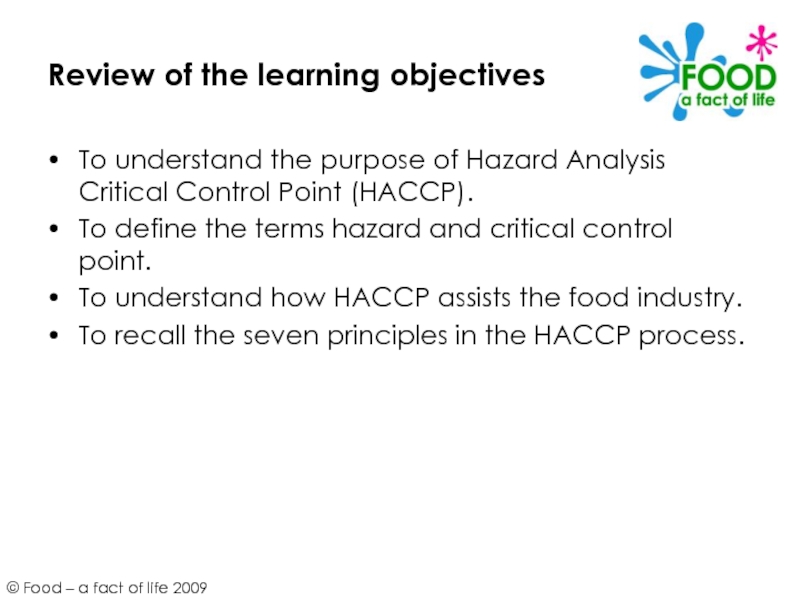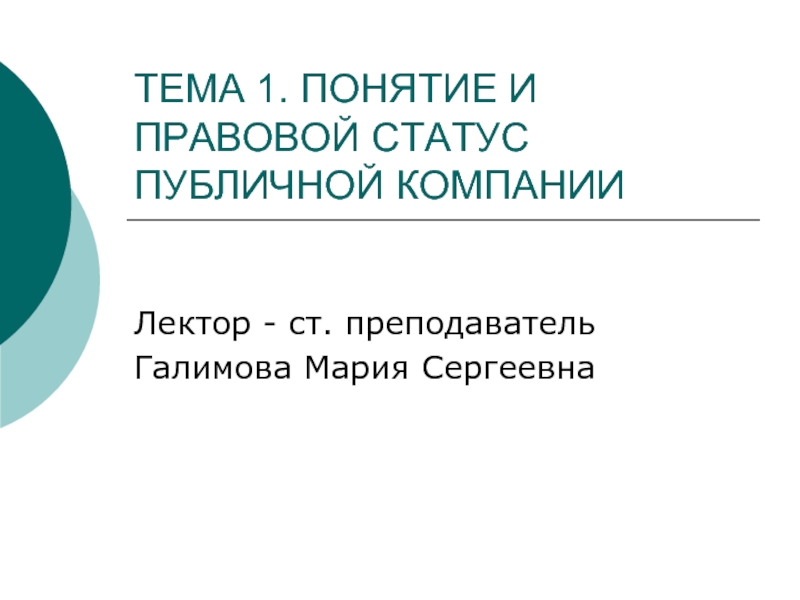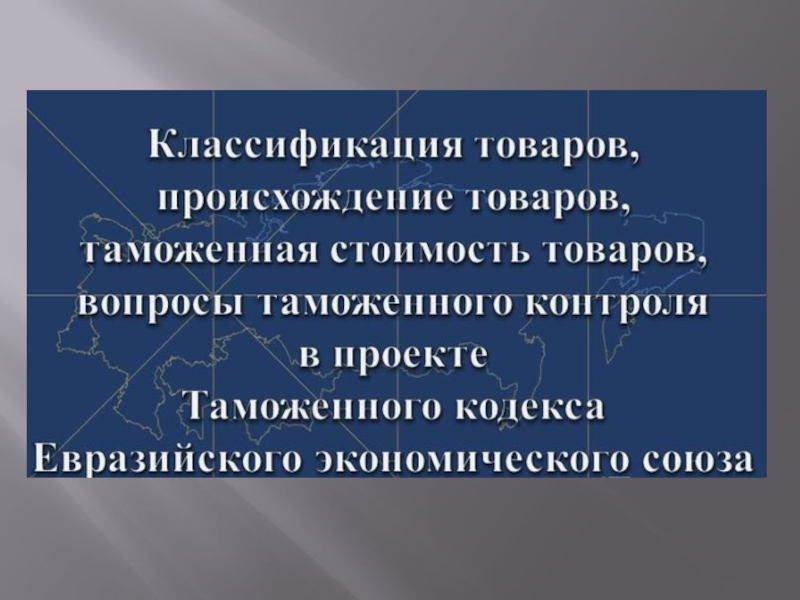- Главная
- Разное
- Дизайн
- Бизнес и предпринимательство
- Аналитика
- Образование
- Развлечения
- Красота и здоровье
- Финансы
- Государство
- Путешествия
- Спорт
- Недвижимость
- Армия
- Графика
- Культурология
- Еда и кулинария
- Лингвистика
- Английский язык
- Астрономия
- Алгебра
- Биология
- География
- Детские презентации
- Информатика
- История
- Литература
- Маркетинг
- Математика
- Медицина
- Менеджмент
- Музыка
- МХК
- Немецкий язык
- ОБЖ
- Обществознание
- Окружающий мир
- Педагогика
- Русский язык
- Технология
- Физика
- Философия
- Химия
- Шаблоны, картинки для презентаций
- Экология
- Экономика
- Юриспруденция
Hazard Analysis Critical Control Point (HACCP) презентация
Содержание
- 1. Hazard Analysis Critical Control Point (HACCP)
- 2. Learning objectives To understand the purpose of
- 3. Legal responsibility Food companies have a legal
- 4. HACCP HACCP stands for ‘Hazard Analysis Critical
- 5. What does it involve? • Identifying points
- 6. Qualities of the HACCP system HACCP is:
- 7. How does HACCP help? HACCP is a
- 8. Hazard A hazard is a biological, chemical
- 9. Types of hazards The types of hazards
- 10. Critical Control Point (CCP) A Critical Control
- 11. Critical Control Point (CCP) Points may be
- 12. Critical Control Point (CCP) CCP may
- 13. Critical Control Point (CCP) Points may be
- 14. • Hazard analysis • Determine the Critical
- 15. 1. Hazard analysis The first step
- 16. 2. Determine the Critical Control Point
- 17. 3. Establish critical limits A critical limit
- 18. 4. Critical Control Point (CCP) monitoring
- 19. 5. Corrective actions Corrective actions, are procedures
- 20. 5. Corrective actions Some examples of corrective
- 21. 6. Verification procedures Verification procedures are those
- 22. 7. Record keeping procedures Documentation and record
- 23. 7. Record keeping procedures Four different types
- 24. Review of HACCP The design and running
- 25. Review of the learning objectives To understand
Слайд 2Learning objectives
To understand the purpose of Hazard Analysis Critical Control Point
(HACCP).
To define the terms hazard and critical control point.
To understand how HACCP assists the food industry.
To recall the seven principles in the HACCP process.
To define the terms hazard and critical control point.
To understand how HACCP assists the food industry.
To recall the seven principles in the HACCP process.
Слайд 3Legal responsibility
Food companies have a legal responsibility to produce safe food.
A
business that breaks the law faces:
• improvement notices – a fixed time period is set for the company to rectify problems;
• prohibition notices – the company is not permitted to produce particular food items;
• prosecution.
• improvement notices – a fixed time period is set for the company to rectify problems;
• prohibition notices – the company is not permitted to produce particular food items;
• prosecution.
Слайд 4HACCP
HACCP stands for ‘Hazard Analysis Critical Control Point’.
HACCP is a system
which looks for and prevents potential problems before they happen.
HACCP may be used by food companies to make sure they do not break the law by putting consumers at risk when producing food.
It is a structured approach to risk assessment and is one means of satisfying the risk assessment requirement of UK hygiene legislation.
HACCP may be used by food companies to make sure they do not break the law by putting consumers at risk when producing food.
It is a structured approach to risk assessment and is one means of satisfying the risk assessment requirement of UK hygiene legislation.
Слайд 5What does it involve?
• Identifying points during the production of a
product where potential hazards may occur.
• Analysing the risk of the hazard points happening including the scale of consequence if they do.
• Deciding which points are critical to consumer safety.
• Implementing controls, monitoring production and taking action if necessary.
• Reviewing the HACCP plan whenever the food operation is altered, and on a regular basis, e.g. annually, even if no alterations have been made.
• Analysing the risk of the hazard points happening including the scale of consequence if they do.
• Deciding which points are critical to consumer safety.
• Implementing controls, monitoring production and taking action if necessary.
• Reviewing the HACCP plan whenever the food operation is altered, and on a regular basis, e.g. annually, even if no alterations have been made.
Слайд 6Qualities of the HACCP system
HACCP is:
• systematic – all the potential
hazards are identified before there is a problem;
• efficient – it concentrates the control effort at the stages where the risk is potentially the highest;
• on the spot – the processes can be controlled immediately by the food business.
• efficient – it concentrates the control effort at the stages where the risk is potentially the highest;
• on the spot – the processes can be controlled immediately by the food business.
Слайд 7How does HACCP help?
HACCP is a method which food businesses can
use to ensure that their products do not put consumers at risk.
The details of a HACCP system will vary as no two businesses are exactly alike – but the principles are the same.
The details of a HACCP system will vary as no two businesses are exactly alike – but the principles are the same.
Слайд 8Hazard
A hazard is a biological, chemical or physical agent that is
reasonably likely to cause illness or injury in the absence of its control.
In HACCP, hazards refer to the conditions or contaminants in foods that can cause illness or injury.
In HACCP, hazards refer to the conditions or contaminants in foods that can cause illness or injury.
Слайд 9Types of hazards
The types of hazards which a HACCP plan can
focus on include:
• biological hazards, e.g. harmful microorganisms;
• chemical hazards, e.g. those either naturally occurring, intentionally added or unintentionally added;
• physical hazards, e.g. glass, stones or metal;
• packaging quality;
• equipment reliability.
• biological hazards, e.g. harmful microorganisms;
• chemical hazards, e.g. those either naturally occurring, intentionally added or unintentionally added;
• physical hazards, e.g. glass, stones or metal;
• packaging quality;
• equipment reliability.
Слайд 10Critical Control Point (CCP)
A Critical Control Point (CCP) is an identifiable
point in the production chain where a hazard may occur.
Action is taken to prevent the hazard from occurring.
This can either be a point, step or procedure at which control can be applied and is essential to prevent or eliminate a hazard or reduce it to an acceptable level.
A CCP can be used to control more than one hazard – refrigeration storage CCP.
Alternatively, several CCPs may be needed to control one hazard.
Action is taken to prevent the hazard from occurring.
This can either be a point, step or procedure at which control can be applied and is essential to prevent or eliminate a hazard or reduce it to an acceptable level.
A CCP can be used to control more than one hazard – refrigeration storage CCP.
Alternatively, several CCPs may be needed to control one hazard.
Слайд 11Critical Control Point (CCP)
Points may be identified as CCP when hazards
can be prevented, for example:
• introduction of chemical residue can be prevented by control at the receiving stage;
• a chemical hazard can be prevented by control at the formulation or ingredient-addition stage;
• pathogenic bacteria growth can be controlled by refrigerated storage or chilling.
• introduction of chemical residue can be prevented by control at the receiving stage;
• a chemical hazard can be prevented by control at the formulation or ingredient-addition stage;
• pathogenic bacteria growth can be controlled by refrigerated storage or chilling.
Слайд 12Critical Control Point (CCP)
CCP may be identified where hazards can be
eliminated, for example:
• pathogenic bacteria can be killed during cooking;
• metal fragments can be detected by a metal detector and eliminated by removing the contaminated product from the processing line;
• parasites can be killed by freezing.
• pathogenic bacteria can be killed during cooking;
• metal fragments can be detected by a metal detector and eliminated by removing the contaminated product from the processing line;
• parasites can be killed by freezing.
Слайд 13Critical Control Point (CCP)
Points may be identified as CCPs when hazards
are reduced to acceptable levels, for example:
• the occurrence of foreign objects can be minimised by manual sorting and automatic collectors;
• some biological and chemical hazards can be minimised by obtaining shellfish from approved waters.
• the occurrence of foreign objects can be minimised by manual sorting and automatic collectors;
• some biological and chemical hazards can be minimised by obtaining shellfish from approved waters.
Слайд 14• Hazard analysis
• Determine the Critical Control Points (CCP)
• Establish critical
limits
• Critical Control Point (CCP) monitoring
• Corrective actions
• Establish verification procedures
• Record keeping procedures
7 principles of HACCP implementation
Слайд 151. Hazard analysis
The first step involves identifying any hazards that
must be prevented, eliminated or reduced to acceptable levels.
All potential hazards, from the receipt of raw materials through to release of the finished product, must be considered.
A hazard must be controlled if it is likely to occur, and/or likely to result in an unacceptable risk to consumers.
All potential hazards, from the receipt of raw materials through to release of the finished product, must be considered.
A hazard must be controlled if it is likely to occur, and/or likely to result in an unacceptable risk to consumers.
Слайд 162. Determine the
Critical Control Point (CCP)
Identifying the Critical Control Point
(CCP) at the steps or at which control is essential to prevent or eliminate a hazard or to reduce it to acceptable levels.
Слайд 173. Establish critical limits
A critical limit is a maximum or minimum
value to which a biological, chemical or physical limit must be controlled at a CCP.
This is set in order to prevent, eliminate or reduce a hazard to an acceptable level.
This is set in order to prevent, eliminate or reduce a hazard to an acceptable level.
Слайд 184. Critical Control Point (CCP)
monitoring
A planned series of observations or
measurements need to be taken to assess whether a CCP is within critical limits.
This also helps to produce an accurate record for future use in verification.
This also helps to produce an accurate record for future use in verification.
Слайд 195. Corrective actions
Corrective actions, are procedures to be followed when a
hazard is identified in the food production.
The aim is to correct and eliminate the cause of the hazard and bring CCP back under control.
The cause of problem must be identified to prevent future recurrence.
Establishing corrective actions when monitoring procedures at CCP is not under control.
The aim is to correct and eliminate the cause of the hazard and bring CCP back under control.
The cause of problem must be identified to prevent future recurrence.
Establishing corrective actions when monitoring procedures at CCP is not under control.
Слайд 205. Corrective actions
Some examples of corrective actions can include:
• isolating and
holding product for safety evaluation;
• diverting the affected product or ingredients to another line where deviation would not be considered critical;
• reprocessing;
• destroying the product.
• diverting the affected product or ingredients to another line where deviation would not be considered critical;
• reprocessing;
• destroying the product.
Слайд 216. Verification procedures
Verification procedures are those activities, other than monitoring CCPs,
that verify the HACCP plan and show the system is operating according to the plan.
This is usually completed annually or when a system fails or there is a significant change in the product or process.
Establishing procedures, which shall be carried out regularly to verify that the measure outlines in the above paragraphs.
This is usually completed annually or when a system fails or there is a significant change in the product or process.
Establishing procedures, which shall be carried out regularly to verify that the measure outlines in the above paragraphs.
Слайд 227. Record keeping procedures
Documentation and record keeping help to demonstrate the
effective implementation of the previous principles of HACCP.
This records could be of the development of the HACCP plan, CCP monitoring, corrective actions or verification activities.
This records could be of the development of the HACCP plan, CCP monitoring, corrective actions or verification activities.
Слайд 237. Record keeping procedures
Four different types of HACCP records include:
1. HACCP
plan and support documentation used in developing the plan.
2. Records of CCP monitoring.
3. Records of corrective actions.
4. Records of verification activities.
2. Records of CCP monitoring.
3. Records of corrective actions.
4. Records of verification activities.
Слайд 24Review of HACCP
The design and running of the HACCP scheme should
be revised whenever the food operation is altered.
The scheme should be reviewed from time to time (e.g. once a year) even when there have been no alterations.
The scheme should be reviewed from time to time (e.g. once a year) even when there have been no alterations.
Слайд 25Review of the learning objectives
To understand the purpose of Hazard Analysis
Critical Control Point (HACCP).
To define the terms hazard and critical control point.
To understand how HACCP assists the food industry.
To recall the seven principles in the HACCP process.
To define the terms hazard and critical control point.
To understand how HACCP assists the food industry.
To recall the seven principles in the HACCP process.
